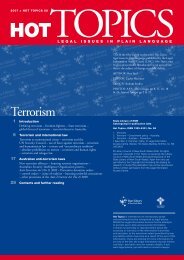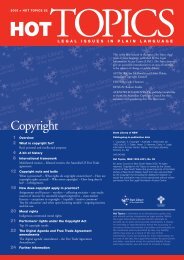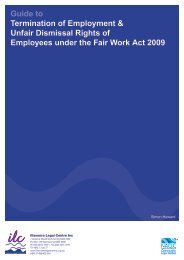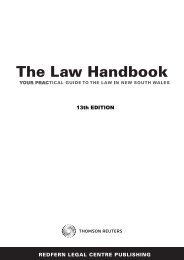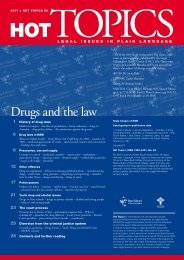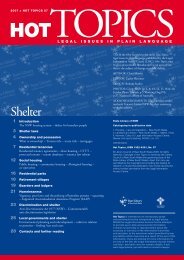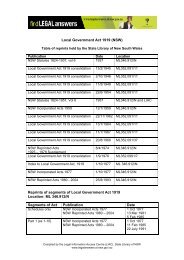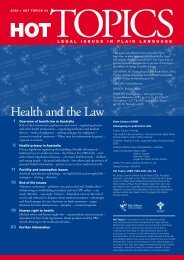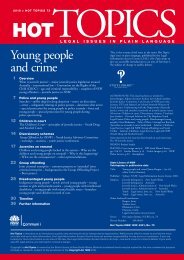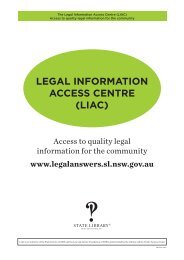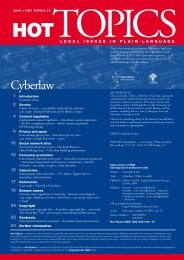Aboriginal people and the law - Legal Information Access Centre
Aboriginal people and the law - Legal Information Access Centre
Aboriginal people and the law - Legal Information Access Centre
You also want an ePaper? Increase the reach of your titles
YUMPU automatically turns print PDFs into web optimized ePapers that Google loves.
66 The Law H<strong>and</strong>bookHeritage <strong>and</strong> culturalprotection[2.440] Protection of heritageThe three main NSW <strong>law</strong>s that addressaspects of Indigenous cultural heritage are<strong>the</strong>:• National Parks <strong>and</strong> Wildlife Act 1974 (NSW)(NPW Act)• Heritage Act 1977 (NSW)• Environmental Planning <strong>and</strong> Assessment Act1979 (NSW).At <strong>the</strong> national level, <strong>the</strong> main <strong>law</strong>s thataddress aspects of Indigenous cultural heritageare <strong>the</strong>:• Environment Protection <strong>and</strong> BiodiversityConservation Act 1999 (Cth)• <strong>Aboriginal</strong> <strong>and</strong> Torres Strait Isl<strong>and</strong>er HeritageProtection Act 1984 (Cth)• Protection of Movable Cultural Heritage Act1986 (Cth).[2.450] The National Parks <strong>and</strong>Wildlife ActCultural sites <strong>and</strong> objectsSites of cultural significance to <strong>Aboriginal</strong><strong>people</strong> can be protected under <strong>the</strong> NationalParks <strong>and</strong> Wildlife Act 1974. These mayinclude:• sacred sites• burial places• rock art• artefacts or relics• occupation sites, including axe-grindinggrooves.<strong>Aboriginal</strong> areasUnder s 30K of <strong>the</strong> Act, l<strong>and</strong> can be reservedas an <strong>Aboriginal</strong> area. The purpose of <strong>the</strong>section is:to identify, protect <strong>and</strong> conserve areas associatedwith a person, event or historical <strong>the</strong>me,or containing a building, place, object, featureor l<strong>and</strong>scape:(a) of natural or cultural significance to <strong>Aboriginal</strong><strong>people</strong>, or(b) of importance in improving public underst<strong>and</strong>ingof <strong>Aboriginal</strong> culture.<strong>Aboriginal</strong> objects <strong>and</strong> placesAn <strong>Aboriginal</strong> object is defined as “anydeposit, object or material evidence” relatingto <strong>Aboriginal</strong> habitation, including <strong>Aboriginal</strong>remains (s 5). An <strong>Aboriginal</strong> place is aplace that has been declared by <strong>the</strong> governmentto be of special significance to <strong>Aboriginal</strong>culture (s 84).Role of <strong>the</strong> Department of <strong>the</strong> EnvironmentThe Director-General of <strong>the</strong> Department of<strong>the</strong> Environment has care <strong>and</strong> control of<strong>Aboriginal</strong> heritage items <strong>and</strong> places. TheDirector-General can issue permits unders 90 of <strong>the</strong> Act that allow someone toexcavate, destroy or o<strong>the</strong>rwise disturb a site,or place, or object. Under s 86, it is anoffence to harm or desecrate an <strong>Aboriginal</strong>object or place, unless <strong>the</strong> Director-Generalhas issued a permit under s 90, or <strong>the</strong>impact is a low-impact activity prescribedby regulation, or <strong>the</strong> defendant has exercisedreasonable due diligence to determinethat no <strong>Aboriginal</strong> object or place would beharmed by <strong>the</strong> activity.A register of <strong>Aboriginal</strong> objects, places<strong>and</strong> sites is kept by <strong>the</strong> Department of <strong>the</strong>Environment <strong>and</strong> is called <strong>the</strong> <strong>Aboriginal</strong>Heritage <strong>Information</strong> Management System.The register can be searched to see ifanything is listed on your l<strong>and</strong>. Applicants



